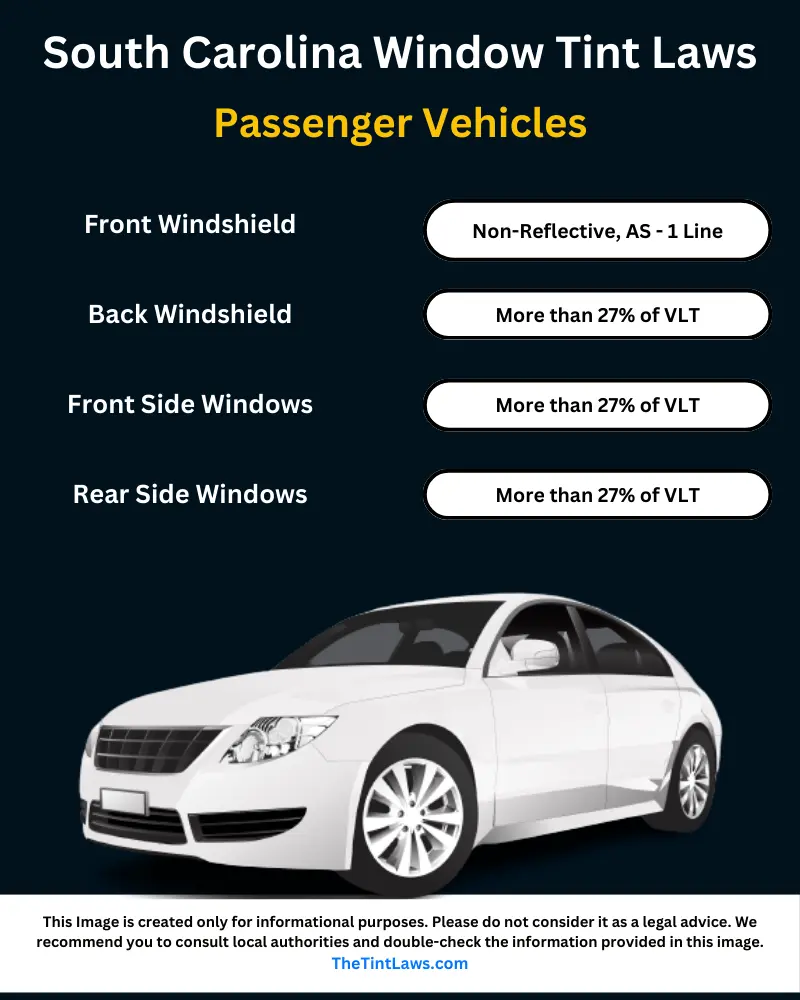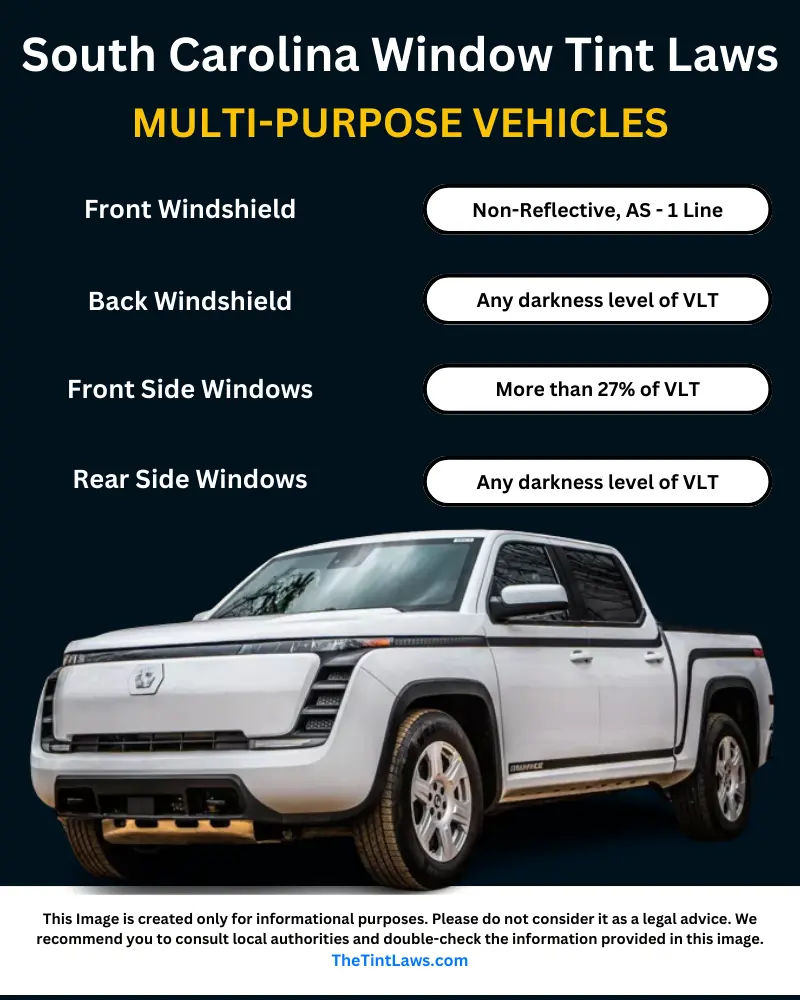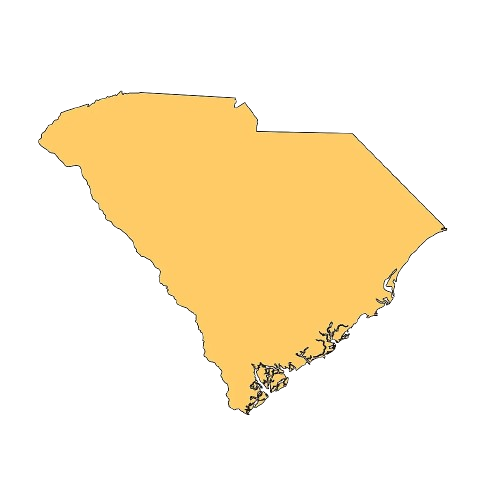Cruising down the beautiful South Carolina coast with the sun beating down? Window tint can be a tempting addition to your car, offering both comfort and protection. But before you get that sleek, dark look, it’s important to understand South Carolina tint laws. Not all tints are created equal, and some can land you with a ticket.
In this Guide, We’ll break down window tint regulations for cars, SUVs, and medical exemptions. We’ll explain what’s allowed on your windshield, side windows, and rear window, so you can ride in style and stay on the right side of the law.
Window Tint laws in South Carolina were enacted in 1992. The legal tint in South Carolina is 27% of VLT for all windows except the front windshield.
South Carolina Tint Laws:
The darkness of your window tint is measured by its Visible Light Transmission (VLT), which indicates the percentage of light allowed through the tinted window. SC tint laws have different VLT requirements for various vehicle types.
Legal tint darkness for sedans:
- Windshield: Only non-reflective tint is allowed above the manufacturer’s AS-1 line.
- Front side windows: More than 27% of VLT should be allowed.
- Back Side windows: More than 27%of VLT should be allowed.
- Rear window: More than 27% of VLT should be allowed.

Legal tint darkness for Trucks:
- Windshield: Only non-reflective tint is allowed above the manufacturer’s AS-1 line.
- Front side windows: More than 27% of VLT should be allowed.
- Back Side windows: Any darkness level of VLT% is allowed.
- Rear window: Any darkness level of VLT% is allowed.

Important Note: It’s crucial to remember that these are the minimum VLT requirements. You can have a lighter tint (higher VLT percentage) as long as it meets the legal limit. However, anything darker than the specified VLT is considered illegal.
Window tint reflection in South Carolina:
South Carolina State restricts the level of reflection allowed in window tint.
Tint Reflection for sedans:
- Front Side windows: Tint laws are not clear about the tint reflection. It is advised to use non-reflection tint.
- Back Side windows: Tint laws are not clear about the tint reflection. It is advised to use non-reflection tint.
Tint Reflection for SUV and Van:
- Front Side windows: Tint laws are not clear about the tint reflection. It is advised to use non-reflection tint.
- Back Side windows: Tint laws are not clear about the tint reflection. It is advised to use non-reflection tint.
South Carolina Window Tinting Rules and Regulations
Beyond darkness and reflection, South Carolina has additional rules to be aware of when tinting your windows.
- Side Mirrors: If the rear window is tinted, the vehicle must have dual side mirrors to ensure adequate visibility.
- Restricted Colors: South Carolina law prohibits red, amber, and yellow colors for window tinting purposes.
- Certificates: Film manufacturers need to certify the films they sell in the state. Ensure your tint installer is using certified film only.
- Stickers: State law requires a sticker indicating that the tint complies with car tinting laws.
- Medical exemptions: South Carolina tint law allows medical exemptions for window tinting. If you have a medical condition that requires darker tinting, you can apply for an exemption with a valid medical reason from a licensed physician. This exemption allows for a lower VLT% than normally permitted by state law.
- Window tinting fines: A violation of South Carolina tint laws can cost you a $200 fine per infraction.
Is 5%, 15%, or 20% tint legal in South Carolina? Only Trucks can have this level of tint on the back side windows and rear window. Sedan Must have more than 27% VLT which is the legal tint percentage.
South Carolina Tints Laws Reference: Read SECTION 56-5-5015. Sunscreen devices.
Information about South Carolina State
South Carolina, located in the southeastern United States, is bordered by North Carolina to the north, Georgia to the southwest, and the Atlantic Ocean to the southeast. Its landscape includes the Blue Ridge Mountains in the northwest, the rolling hills of the Piedmont in the center, and the Atlantic Coastal Plain with beautiful beaches and marshlands. South Carolina enjoys a humid subtropical climate, with hot and humid summers and mild winters.

Capital
Columbia
Population
38,965,193 (2023)
Area
32,020 mi² (82,931. km2)
Major cities in South Carolina:
Abbeville, Aiken, Anderson, Bamberg, Barnwell, Beaufort, Belton, Bennettsville, Bishopville, Camden, Cayce, Charleston, Cheraw, Chester, Clemson, Clinton, Columbia, Conway, Darlington, Dillon, Easley, Florence, Folly Beach, Forest Acres, Gaffney, Georgetown, Greenville, Greenwood, Greer, Hardeeville, Hartsville, Hemingway, Isle of Palms, Johnsonville, Lancaster, Laurens, Liberty, Manning, Marion, Mauldin, Myrtle Beach, Newberry, North Augusta, North Charleston, North Myrtle Beach, Orangeburg, Pickens, Rock Hill, Seneca, Simpsonville, Spartanburg, Summerville, Sumter, Tega Cay, Travelers Rest, Union, Walhalla, Walterboro, West Columbia, Westminster, Williston, Winnsboro, Woodruff, and York.
Major counties in South Carolina:
Abbeville, Aiken, Allendale, Anderson, Bamberg, Barnwell, Beaufort, Berkeley, Calhoun, Charleston, Cherokee, Chester, Chesterfield, Clarendon, Colleton, Darlington, Dillon, Dorchester, Edgefield, Fairfield, Florence, Georgetown, Greenville, Greenwood, Hampton, Horry, Jasper, Kershaw, Lancaster, Laurens, Lee, Lexington, Marion, Marlboro, McCormick, Newberry, Oconee, Orangeburg, Pickens, Richland, Saluda, Spartanburg, Sumter, Union, Williamsburg, and York.